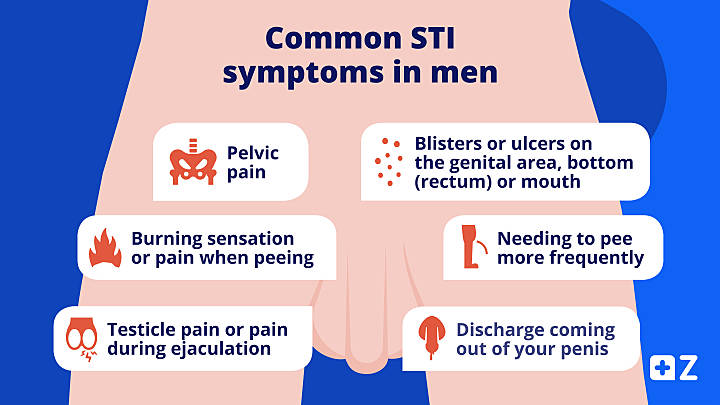What causes STD/STI diseases?
It is usually through sexual contact that sexually transmitted diseases (STDs) or sexually transmitted infections (STIs) are contracted. Blood, semen, vaginal fluids, and other bodily fluids may contain bacteria, viruses, or parasites that cause sexually transmitted diseases. In this article, I will be discussing What causes STD/STI diseases?.
Sometimes, these infections can be transmitted non-sexually. For example, when mothers pass them on to their infants during pregnancy or childbirth, or when blood is transfused or a needle share is used.
There are not always symptoms associated with STIs. Many people don’t take advantage of the fact that they may have an infection unless they know they have one. However, even healthy people can contract sexually transmitted infections.
Symptoms of STD/STI diseases
It is possible for STDs or STIs to have no symptoms at all, as well as a range of signs and symptoms. It is because of this that complications and the diagnosis of a partner may not be noticed until complications occur.
 This image is a courtesy of ZAVA UK
This image is a courtesy of ZAVA UK
There are a number of symptoms and signs that could indicate an STI, including:
-
A sore or bump in the genital area, the oral cavity, or the rectal cavity
-
Having a painful or burning experience while urinating
-
The discharge of the penis
-
An unusual or odorous discharge from the vaginal area
-
Bleeding from the vaginal area that is unusual
-
A painful experience during sex
-
Lymph nodes that are painful and swollen, especially in the groin but can spread to other areas as well
-
A feeling of lower abdominal pain
-
Feeling feverish
-
A rash that affects the trunk, hands, or feet
It may take a few days after exposure for signs and symptoms to appear. Depending on the organism responsible for the STI, it may take years before you have any noticeable symptoms.
The right time to see a doctor

If you experience any of the following symptoms, see a doctor immediately:
-
A sexually transmitted infection may have been contracted because you are sexually active
-
There are signs and symptoms of an STI in you
Call your doctor to schedule an appointment:
-
You should start thinking about becoming sexually active when you are 18 or 21 years old, whichever comes first
-
You should always check with your partner before you begin having sex with them
Read about more Information on STI
:max_bytes(150000):strip_icc()/std-causes-3133097-Final-c1cc7e2214db4a22bb86718681dba7cd.png)
Causes of STD/STI diseases
STDs or STIs can be caused by:
-
Bacteria: STIs that are caused by bacteria include gonorrhea, syphilis, and chlamydia.
-
Parasites: The parasite that causes trichomoniasis is an STI.
-
Viruses: The most common STIs caused by viruses are HPV, genital herpes, and HIV.
In addition to hepatitis A, B, and C virus infections, shigella infection, and giardia infection, they can be spread through sexual activity. However, you can contract an infection without engaging in sexual activity.
Factors that increase risk of STI
It is possible that anyone who has a sexual relationship might be exposed to an STD or STI at some point. This risk may be increased by the following factors:
1. The act of having sex without protection.
Infected partners who aren’t wearing a latex condom and who penetrate vaginally or anally significantly increase their risk of contracting an STI. It is also possible to increase the risk by using condoms improperly or inconsistently.
The risk of spreading infections during oral sex is lower, but without a latex condom or a dental dam – a thin, square piece of rubber made from silicone or latex – the risk is still present.
2. Engaging in sexual activity with more than one partner at a time.
A person’s risk of developing sexually transmitted diseases increases as their contact with more people increases.
-
Being infected with STIs in the past: An STI that has already taken hold makes it much easier for the next STI to follow.
-
Having to engage in sexual activity under duress: If you have been raped or assaulted, it is imperative to see a doctor as soon as possible. This is so that you can be screened, treated, and provided with emotional support.
-
Drinking alcohol or using recreational drugs: When you misuse substances, your judgment can be impaired, making you more likely to engage in risky behavior.
-
Taking drugs by injection: Several serious infections are spread through the sharing of needles, including HIV, hepatitis B, and hepatitis C.
-
The prospect of being young: A quarter of all newly diagnosed STIs are contracted by people between the ages of 15 and 24.
3. Infants are transmitted from their mothers
It is possible for mothers to pass certain STIs to their infants during pregnancy or delivery, such as gonorrhea, chlamydia, HIV, and syphilis. There are serious problems and even death associated with STIs in infants. There should be screenings and treatments available for women who are pregnant for these infections.
Aspects of complications
STI screening is needed to prevent complications because many people with an STD or STI do not experience symptoms during the early stages of the disease.
Among the possible complications are:
-
Pelvic inflammatory disease
-
Eye inflammation
-
Heart disease
-
Complications during pregnancy
-
Pain in the pelvis
-
Certain types of cancer, such as cervical and rectal cancer associated with HPV, can be caused by
-
Arthritis
-
An infertility problem
Prevention
You can prevent or reduce your risk of STDs or STIs in a number of ways.
1. Please abstain.
Sexually transmitted infections can be prevented by not engaging in or abstaining from sex.
2. You should stay with one uninfected partner.
Staying in a long-term relationship in which both people have sex only with each other and neither is HIV-positive is another way to avoid STIs.
3. Test and wait.
If you have just started dating someone, do not engage in vaginal and anal interactions until you have been tested for STIs. The risk of skin-to-skin contact between the mucous membranes in the oral and genital areas is lower with oral sex, but a latex condom or dental dam is recommended to protect the mucous membranes.
4. Make sure you get vaccinated.
The prevention of certain types of STIs can also be achieved through early vaccination, before sexual exposure. The human papillomavirus (HPV), hepatitis A, and hepatitis B viruses can all be prevented with vaccines.
Girls and boys should get the HPV vaccine between 11 and 12 years of age, although it can be given as early as 9 years of age according to the Centers for Disease Control and Prevention (CDC). The CDC recommends getting the vaccine until age 26 if you are not fully vaccinated at 11 and 12.
Children usually receive the hepatitis B vaccine at birth, while children who are one year of age receive the hepatitis A vaccine. These vaccines should be administered to people who are not immune to these diseases already. Further, they are recommended for people who are at a higher risk of infection, such as those who have sex with men and those who take IV drugs.
5. The use of condoms and dental dams should be consistent and correct.
Each time you perform a sexual act, whether it is oral, vaginal, or anal, you should use a newly prepared latex condom or dental dam. It is not recommended to use oil-based lubricants, such as petroleum jelly, with latex condoms or dental dams.
There is no research to support the effectiveness of condoms made from natural membranes in preventing STIs. Latex condoms are effective at reducing the risk of exposure to most STIs. However, they are less effective at protecting you from STIs that cause exposed sores such as HPV or herpes.
In addition, non-barrier forms of contraception, such as birth control pills and intrauterine devices (IUDs), do not protect against STIs.
6. Avoid excessive alcohol consumption and drug use.
Under the influence of alcohol, you are more likely to commit sexual crimes.
7. Engage in communication.
Ensure that you and your partner have a discussion about safe sex before any serious sexual contact takes place. Make sure you agree on the activities that are permitted and those that are not.
8. Consider circumcision for men.
A circumcision can help men reduce their risk of contracting HIV by as much as 60% when they are sexually active with a woman who has HIV. Circumcision of the male genital region may also lower the risk of transmission of genital herpes and HPV.
9. Preexposure prophylaxis (PrEP) should be considered.
Those who are at a very high risk of contracting HIV can use two combination therapies approved by the Food and Drug Administration (FDA) to reduce their risk. There are two types of antiviral medications: emtricitabine plus tenofovir alafenamide fumarate (Descovy) and emtricitabine plus tenofovir disoproxil fumarate (Truvada).
If you are not already infected with HIV, your doctor will prescribe these drugs to you for HIV prevention. As long as you are taking PrEP, you must have an HIV test before starting it and every three months thereafter.
A urine test will be performed before your doctor prescribes Truvada, and it will be repeated every six months after you begin taking it. The diagnosis of hepatitis B should be confirmed by an infectious disease specialist or a liver specialist before you begin treatment.
Following the instructions for taking these medications every day is essential. Injection drug use and sex can lower your risk of HIV by 74% percent and 99%, respectively, if you take Truvada daily. In this regard, there is consensus among the Centers for Disease Control and Prevention (CDC). According to research, Descovy reduces the risk of contracting HIV through sex in a similar way. Despite this, Descovy hasn’t been studied in people who have receptive vaginal sex. You can further reduce your risk of HIV transmission by using additional prevention methods, such as condoms.
